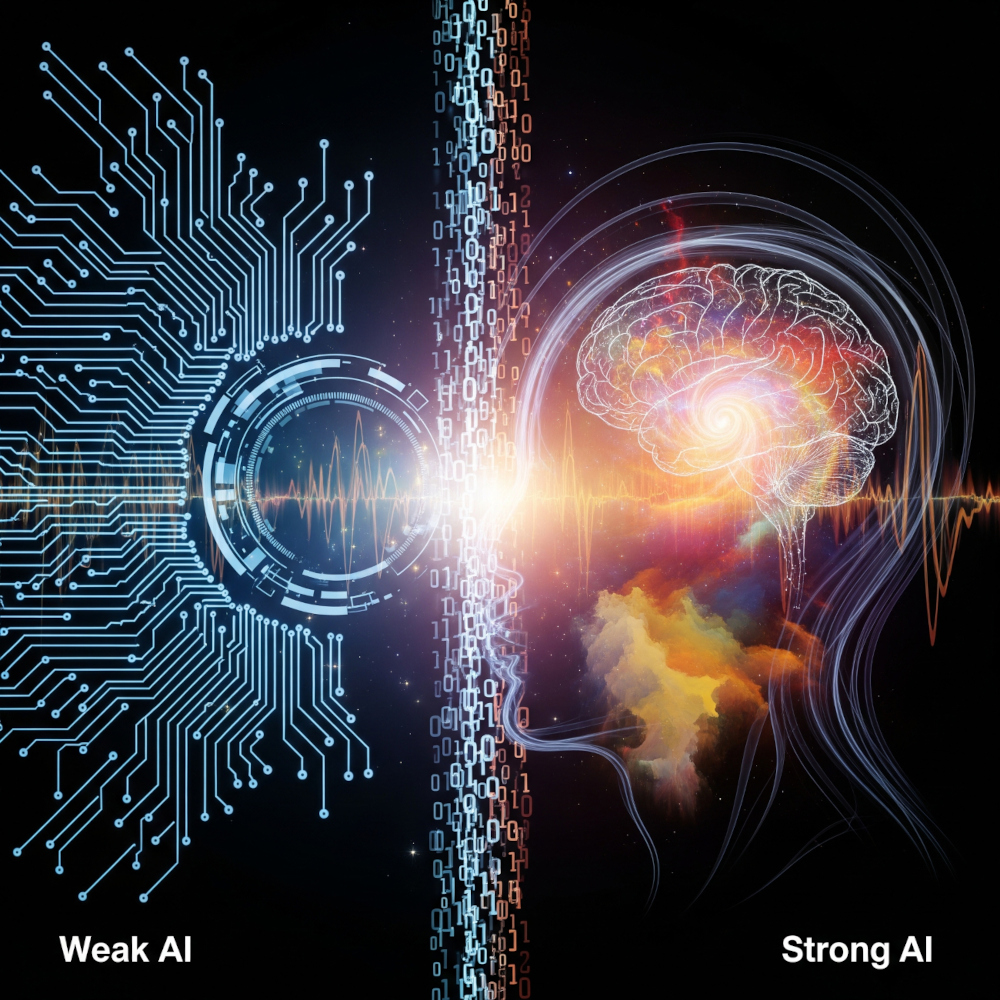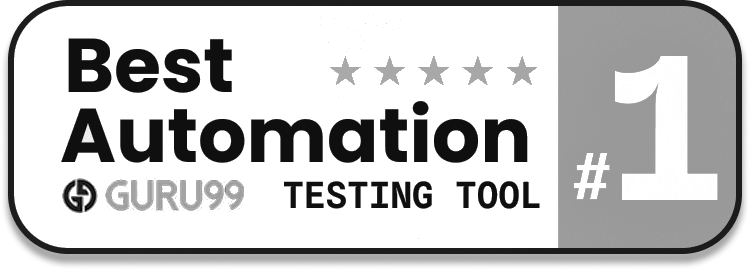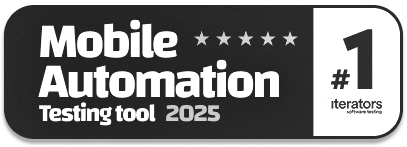Weak AI vs. Strong AI
|
|
You’ve probably heard a lot about Artificial Intelligence lately. From the smart speaker that answers your questions to the recommendations you get on streaming services, AI seems to be everywhere. It’s quickly changing how we live and work, and it’s certainly having a big impact on areas like software development and testing.
But here’s the thing: “AI” is not a single thing. It’s in fact a category that embraces a wide range of technologies. When it comes to understanding what AI actually can and cannot do, especially in practice, it’s important to distinguish between its core forms.
This article will break it down into two main categories: Weak AI and Strong AI.
| Key Takeaways: |
|---|
|

What Exactly is Weak AI (or Narrow AI)?
When we talk about AI in our daily lives – whether it’s your phone’s voice assistant or the personalized suggestions you see online – we’re almost always talking about Weak AI. It’s also often called Narrow AI because, well, it’s pretty narrow in its capabilities.
Imagine Weak AI is like a specialist. It is designed and trained to accomplish one specific task, and it does that job remarkably well. It is not a general intelligence, and doesn’t have the full variety of understanding that a human does. Rather, it imitates intelligent behavior. It’s like a super-powerful calculator capable of performing trigonometric functions, but utterly incapable of holding a conversation or painting a picture.
Here’s what makes Weak AI tick:
- Single-Purposed: Its purpose is to serve a single function. A Weak AI programmed to play chess will only ever play chess – it won’t start penning poetry or driving a car.
- Rule-Based / Pattern-Based: These systems work based on some set of predetermined rules, or (more likely in the case of modern AI) by being able to identify complex patterns within massive datasets. They are very good at spotting correlations and extrapolating to make predictions based on what they’ve “learned” from their training data.
- No Real Comprehension or Awareness: This is critical. Weak AI can perform tasks that appear intelligent, but it has no self-awareness, feelings, or actual understanding of the concepts it’s manipulating. It’s just great at pattern matching and execution.
- Dependency on Big Datasets for Training: Weak AI is often required to be “fed” with copious data related to its field to become an expert. With this information, it is able to find patterns, make decisions and increase its performance over time.
You interact with Weak AI constantly. Here are some everyday examples:
- Voice Assistants (like Siri, Alexa, and Google Assistant): They can understand your commands, set alarms, play music, and answer questions by processing your speech and pulling information from databases. But they don’t understand your emotions, or suddenly decide to write a novel.
- Recommendation Engines (think Netflix or Amazon): These systems analyze your past viewing or purchasing habits and compare them with those of millions of other users to suggest new movies, shows, or products you might like.
- Your Email’s Spam Filters: These employ Weak AI to look for the patterns that symbolize spammers’ unwanted emails so that your inbox isn’t overloaded.
- Image Recognition Software: Be it tagging people’s faces in your pictures or aiding self-driving cars in recognizing pedestrians and traffic signs, this AI is designed to recognize visual patterns.
This sort of focused AI is, interestingly enough, what’s behind a lot of innovation that’s happening in software testing. Tools use some form of advanced Weak AI to understand plain English test steps, adapt a test suite when a small change to the application is made (called “self-healing”), or to “intelligently” determine where on the screen an element is. It means testers can generate and maintain tests far more quickly and reliably, concentrating on what they test, rather than being buried in complex coding or regular undertakings with mere maintenance.
Here are some interesting reads on a related note:
- AI In Software Testing
- AI Agents in Software Testing
- AI Assistants vs AI Agents: How to Test?
- Retrieval Augmented Generation (RAG) vs. AI Agents
- How, When, and Why Top QA Engineers Use AI in Testing?
What is Strong AI?
Now, let’s shift our focus from the AI we interact with daily to something much more ambitious, and currently, still largely theoretical: Strong AI. You might also hear this referred to as Artificial General Intelligence (AGI).
If Weak AI is a specialist, Strong AI is envisioned as a generalist, much like a human being. The goal of Strong AI is to create machines that possess human-level cognitive abilities across a vast range of tasks. This means an AGI wouldn’t just be good at one thing; it would be able to learn, reason, solve problems, understand complex ideas, and apply its knowledge in completely new and unexpected situations, just as a person would. Imagine an AI that could learn to play any board game, write a compelling novel, diagnose a rare disease, and even cook dinner, all without being specifically programmed for each of those tasks.
Here’s what defines Strong AI, in theory:
- Human-Level Cognitive Abilities: This is the core idea. Strong AI would be capable of abstract thought, creativity, common sense, and the ability to learn continuously and transfer knowledge between different domains.
- General Problem-Solving: Unlike Weak AI, which is limited to pre-defined problems, AGI would be able to tackle novel challenges and come up with creative solutions without prior specific training for that exact problem.
- Consciousness: Now it starts to get truly interesting and ponderous. Many in the field believe that for an AI to have general intelligence – that is, to say we’ve built an AI that can reason and process things in the same way a human does – it would require some form of consciousness, self-awareness, and experience of phenomena.
- Ability to Learn and Adapt Across Domains: An AGI would not be confined to the data it was trained on for a narrow task. It would be capable of learning new skills and transferring its knowledge to new environments and problems, with the flexibility of a human mind.
So, how far along are we with Strong AI?
The fact of the matter is this: Strong AI is still a goal for the future and not something we have accomplished yet. Even with the rapid pace of Narrow AI, we are very far off from producing anything resembling a machine that has genuine general intelligence.
The challenges are immense. We don’t yet even know or fully understand human consciousness, or how the brain achieves its magnificent, alchemic versatility. Mimicking that in a machine will need breakthroughs in areas like common sense, true intuition, and being able to make sense out of the sheer complexity of the real world in an open-ended manner. There are also massive moral questions if AGI were ever to be a thing, like control, autonomy, and what intelligence truly is.
Strong AI is not here, not yet, but you may have met it in science fiction. Consider figures such as HAL 9000 from “2001: A Space Odyssey” or Data from “Star Trek: The Next Generation.” These fictions show us part of how an actually sentient, generally intelligent AI could be – free to act, live, and explore, for good or for bad.
Weak AI vs. Strong AI: The Core Differences at a Glance
To solidify the contrast between Weak AI and Strong AI, let’s compare their defining features side-by-side. This contrast illustrates why they are essentially distinct, though both fit under the category “Artificial Intelligence.”
| Feature | Weak AI (Narrow AI) | Strong AI (Artificial General Intelligence – AGI) |
|---|---|---|
| Scope | Narrow/Specific: Designed for one specific task. | Broad/General: Aims for human-level intelligence across many tasks. |
| Capability | Task-Specific: Excels at its designated function only (e.g., playing chess, facial recognition). | Human-level Intelligence: Capable of learning, reasoning, and adapting to any intellectual task. |
| Consciousness | Lacks: Does not possess self-awareness, emotions, or true understanding. Simulates intelligence. | Possesses (Theoretical): Often theorized to have self-awareness, consciousness, and subjective experience. |
| Current Reality | Exists Now: Powering most of the AI applications we use today. | Hypothetical/Future Goal: Not yet achieved; remains a significant research challenge. |
| Learning | Data-Driven Patterns: Learns by identifying patterns and correlations in large datasets for its specific task. | General Understanding & Reasoning: Capable of learning from experience, applying common sense, and reasoning in novel situations. |
| Development Complexity | Relatively Manageable: Complex, but achievable with current technology and vast data. | Immensely Complex: Requires fundamental breakthroughs in understanding intelligence, consciousness, and computational power. |
Why This Distinction Matters
Understanding the difference between Weak AI and Strong AI isn’t just an academic exercise; it has very real, practical implications for how we view, develop, and interact with artificial intelligence. Getting this distinction right helps us to use AI effectively and responsibly.
Here’s why it truly matters:
- Realistic Expectations of AI: The media often blurs the lines between what AI can do now and what it might do in some distant future. By knowing that nearly all current AI is Weak AI, we can temper our expectations. Your voice assistant isn’t plotting world domination; it’s just really good at processing commands within its programming. This clarity helps prevent both irrational fears and unrealistic hype, allowing businesses and individuals to make informed decisions about AI adoption.
- Focus of Current AI Development: Because Strong AI is still a theoretical concept with immense hurdles, almost all the significant advancements and investments in AI today are concentrated on making Weak AI even better. Researchers and engineers are pushing the boundaries of what specialized AI systems can achieve, making them faster, more accurate, and capable of handling increasingly complex, narrow tasks. This focus has led to the incredible breakthroughs we see in areas like medical diagnostics, natural language processing, and predictive analytics.
- Ethical Considerations: The ethical discussions surrounding Weak AI and Strong AI are vastly different.
- For Weak AI, the ethical concerns often revolve around issues like data privacy (how is our data being used to train these systems?), bias (if the training data is biased, the AI’s outputs will be too), job displacement, and accountability for errors. These are immediate, tangible problems we’re grappling with right now.
- For Strong AI, the ethical questions delve into far deeper, existential territory: What rights would a conscious AI have? How do we ensure it aligns with human values? What are the risks if an AGI decides its goals conflict with ours? These are critical long-term considerations that futurists and ethicists are exploring, even if the technology itself is still far off.
- Impact on Industries:
- Weak AI is actively transforming industries right now. In healthcare, it assists with image analysis for disease detection. In finance, it’s used for fraud detection and algorithmic trading. In customer service, chatbots handle routine inquiries. These are real, measurable impacts leading to increased efficiency and new capabilities.
- The impact of Strong AI, on the other hand, remains speculative. While the potential for an AGI to solve humanity’s greatest challenges (like climate change or incurable diseases) is immense, its arrival would also usher in unprecedented societal changes that are hard to predict. It’s a powerful vision, but one that currently exists only in research labs and philosophical discussions.
Conclusion
Strong AI remains where it does – a dream that drives more inquiry into science as an inspiration and source of material for sci-fi. The practical foreseeable future is the continued greater development and smart application of Weak AI. The advances that we observe today, such as the technology behind the kind of advanced test automation tools that we work on, are clear examples of AI’s transformational potential, even as the quest for truly general intelligence remains unanswered.
| Achieve More Than 90% Test Automation | |
| Step by Step Walkthroughs and Help | |
| 14 Day Free Trial, Cancel Anytime |












